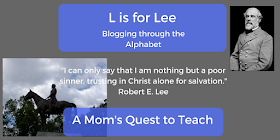I debated about which historical event or figure I wanted to write about for the letter L but finally settled on Robert E. Lee. (Can you tell I love studying about the American Civil War?) Robert E. Lee is a controversial figure in today's world due to the fact that he was a general in the Confederate Army but I do not think his choice to fight for his state of Virginia makes him any less of an important historical figure and great tactician. We should not judge the people of the past by the standards of today. Keeping slaves was and is wrong but I do not think we can ignore the military talents of men like Lee, Stonewall Jackson, or others just because they fought for the 'wrong side.'
Robert E. Lee had two ancestors who signed the Declaration of Independence and his father, Henry Lee (also known as "Light Horse Harry") had a distinguished military career during the Revolutionary War. In fact, "Light Horse Harry" Lee gave the eulogy in which the famous words – "First in war, first in peace, and first in the hearts of his countrymen" – were said of George Washington. Unfortunately, "Light Horse Harry" also speculated with family money and left the United States when Lee was a young boy leaving Robert as the 'head of the family.'
Lee entered the Untied States Military Academy at West Point in 1825 and graduated second in his class four years later. He was a staff officer during the Mexican War and continued to attend to an impressive resume including superintendent at West Point and a lieutenant colonel in a cavalry regiment. Lee also served in the engineers office in Washington and supervised the engineering work for the St. Louis harbor and the Mississippi and Missouri Rivers.
He was offered the command of the main Union Army outside of Washington once the Civil War broke out but he chose not to take the offer. Even though he did not agree with secession, he resigned from the U.S. Army when Virginia seceded. In the early years of the Civil War, Lee's career was not amazing and his reputation dropped.
It wasn't until the wounding of General Joseph E. Johnson that Jefferson Davis gave the command of the Army of Northern Virginia to Lee on June 1, 1862. People had doubts if Lee was the right man for the job. Some even went so far as to write in letters and diaries that they felt Robert E. Lee was the wrong man for the job.
Lee looked the part of a soldier. He was 55 years old and just under 6 feet tall. He was a modest, religious man who always wanted to take the offensive in war. He wanted to deny the enemy the ability to dictate the action. Lee did not feel comfortable with being on the defensive so he wanted to maintain the initiative in battle.
In the first 'battle' with Lee in charge of the Army of Northern Virginia, they pushed General McClellan back in a series of engagements known as the Battles of the Seven Days. He then went on to lead the Confederates at the Second Battle of Bull Run, Battle of Antietam, and Battle of Fredericksburg. It was at the Battle of Fredericksburg that Lee said, "It is well that war is so terrible – we would grow too fond of it."
Lee led the Confederate Army in several more battles (you can read about the Battle of Gettysburg in my G is for Gettysburg post) but the end to the Civil War approached soon after Lee was made general in chief of all the Confederate armies. On April 9, 1865, Lee surrendered to Ulysses Grant at the McLean House at Appomattox Court House in southern Virginia.
After the war was over, a series of mishaps took place that restricted Lee's ability to regain his right to vote as a citizen of the United States. He had sought an individual pardon but his oath of allegiance to the US was lost until 1970. So it wasn't until 1975, over one-hundred years after the end of the Civil War, that Congress restored Lee's full citizenship.
He served as the president of Washington College in Lexington, VA and urged his students and friends to accept the result of the Civil War. He did not wish to encourage any bitterness in Southerners towards the North.
After a brief illness, Robert E. Lee died on October 12, 1870. He was buried in the chapel at Washington College even though his own home of Arlington has been turned into the Arlington National Cemetery. The United States government made Arlington a national cemetery in 1864 and occupies part of the land that belonged to Lee's wife – Mary Custis Lee (the only surviving child of George Washington Parke Custis – George Washington's step-grandson). During the Civil War, many Union soldiers considered the destruction and desolation done to Lee's former home to be a form of justice for him leaving with Virginia.
 |
| © Emkaplin | Stock Free Images |
There are numerous books written about Robert E. Lee as well as essays, articles, and presentations. In fact, he is often central to the the idea of the Lost Cause myth that is often written about by Civil War historians.
If you enjoyed this post, please check out my other Civil War posts.
Resources
We own all four books and I am slowly working my way through all four of them.










No comments:
Post a Comment